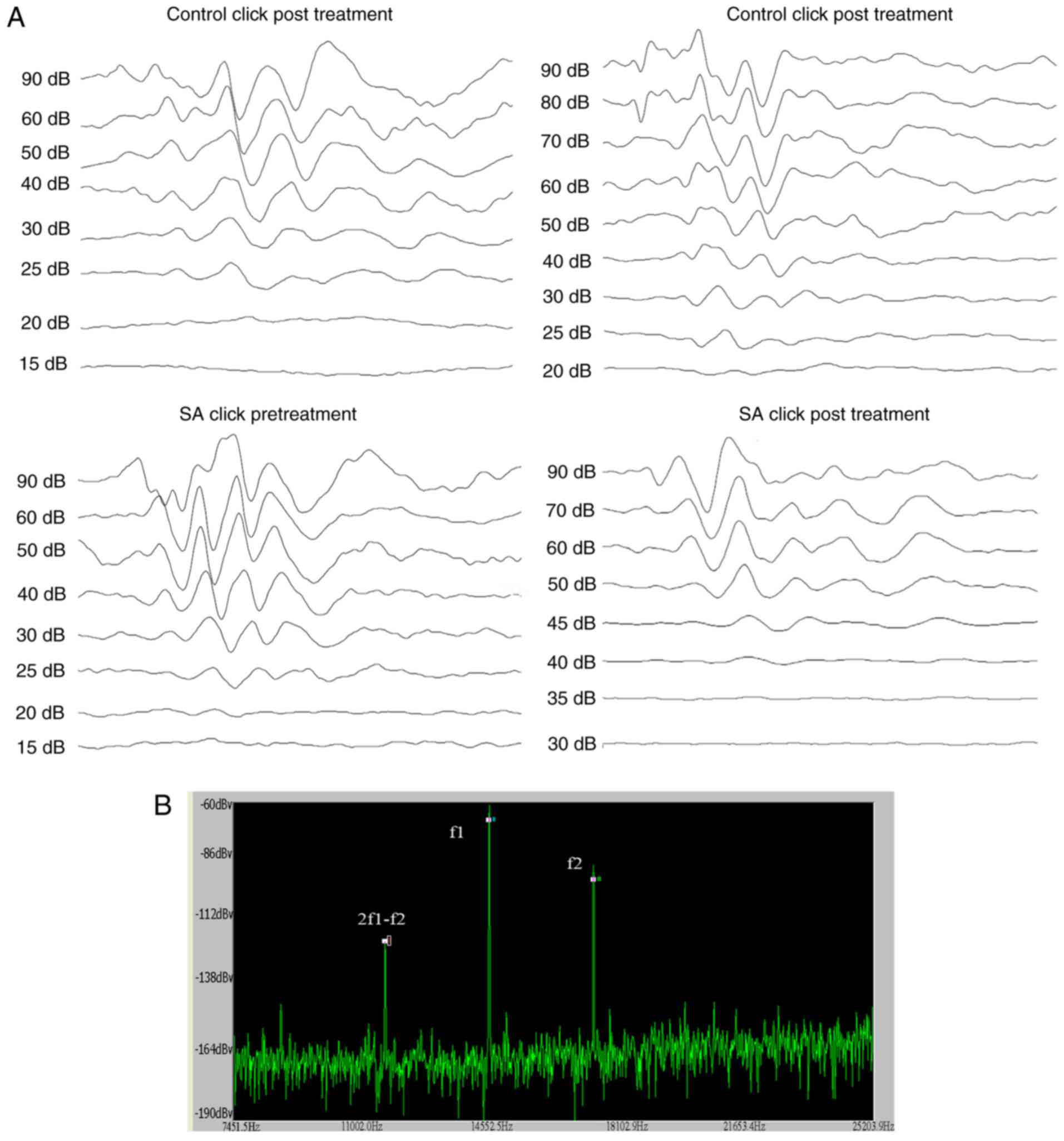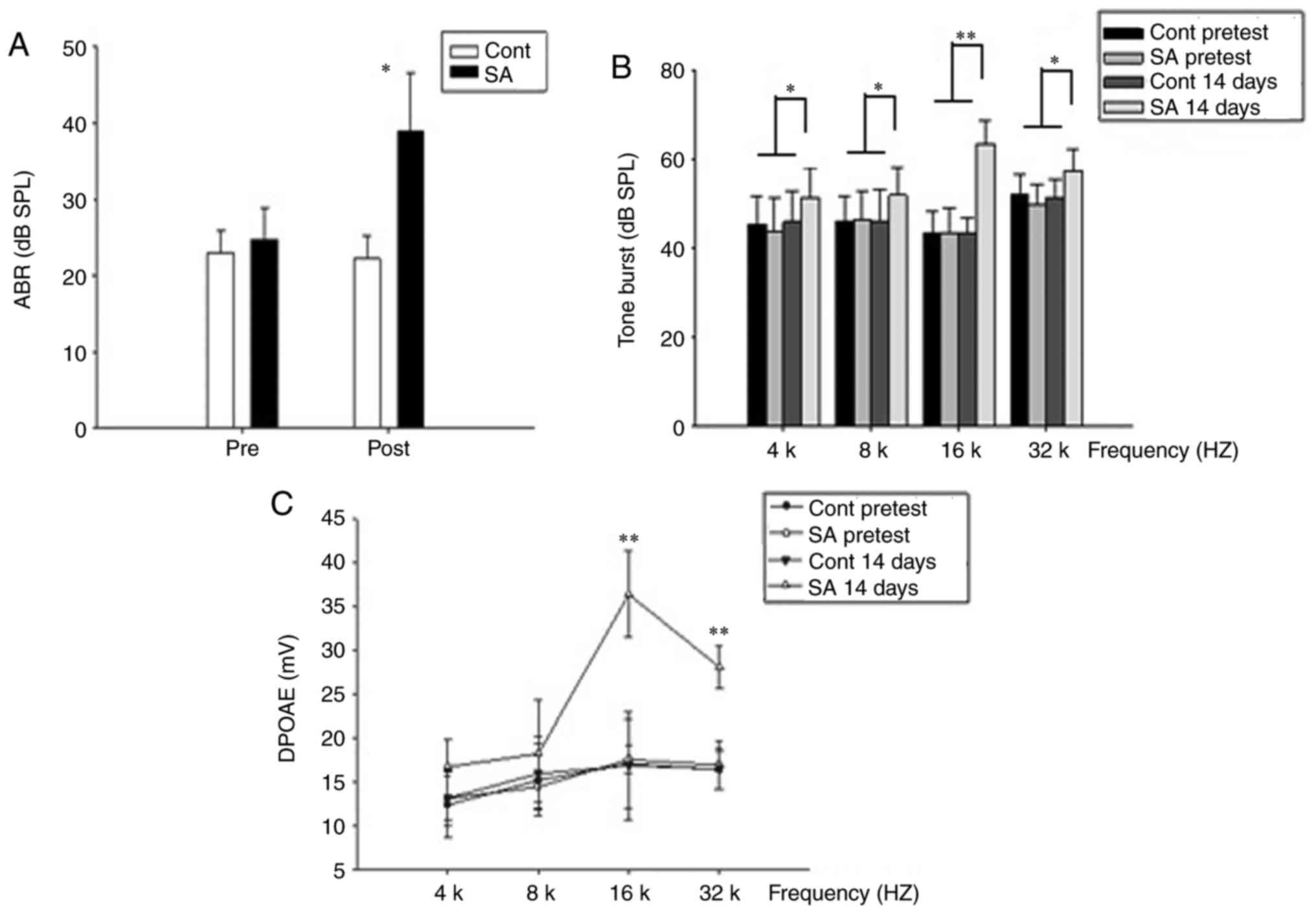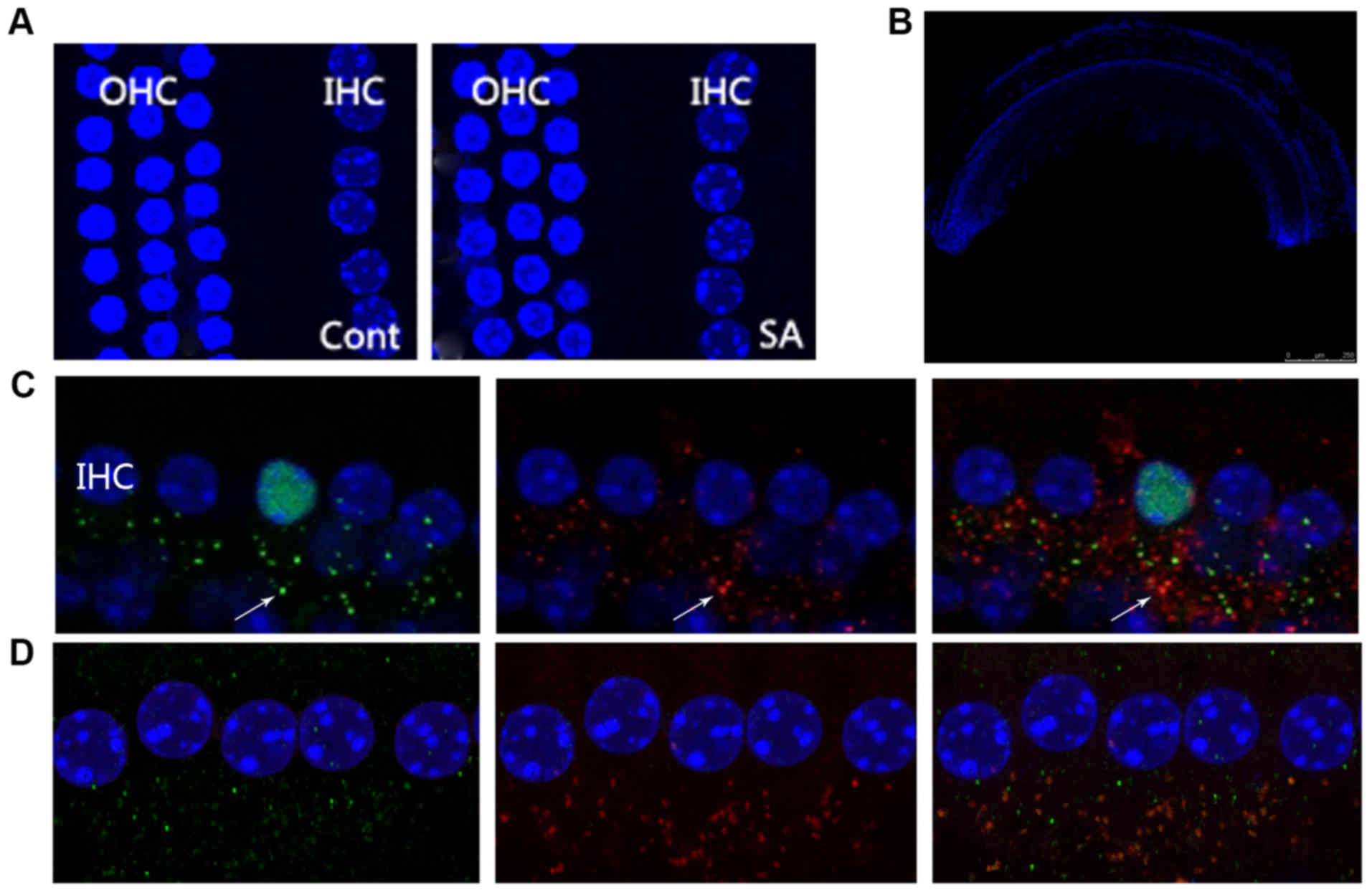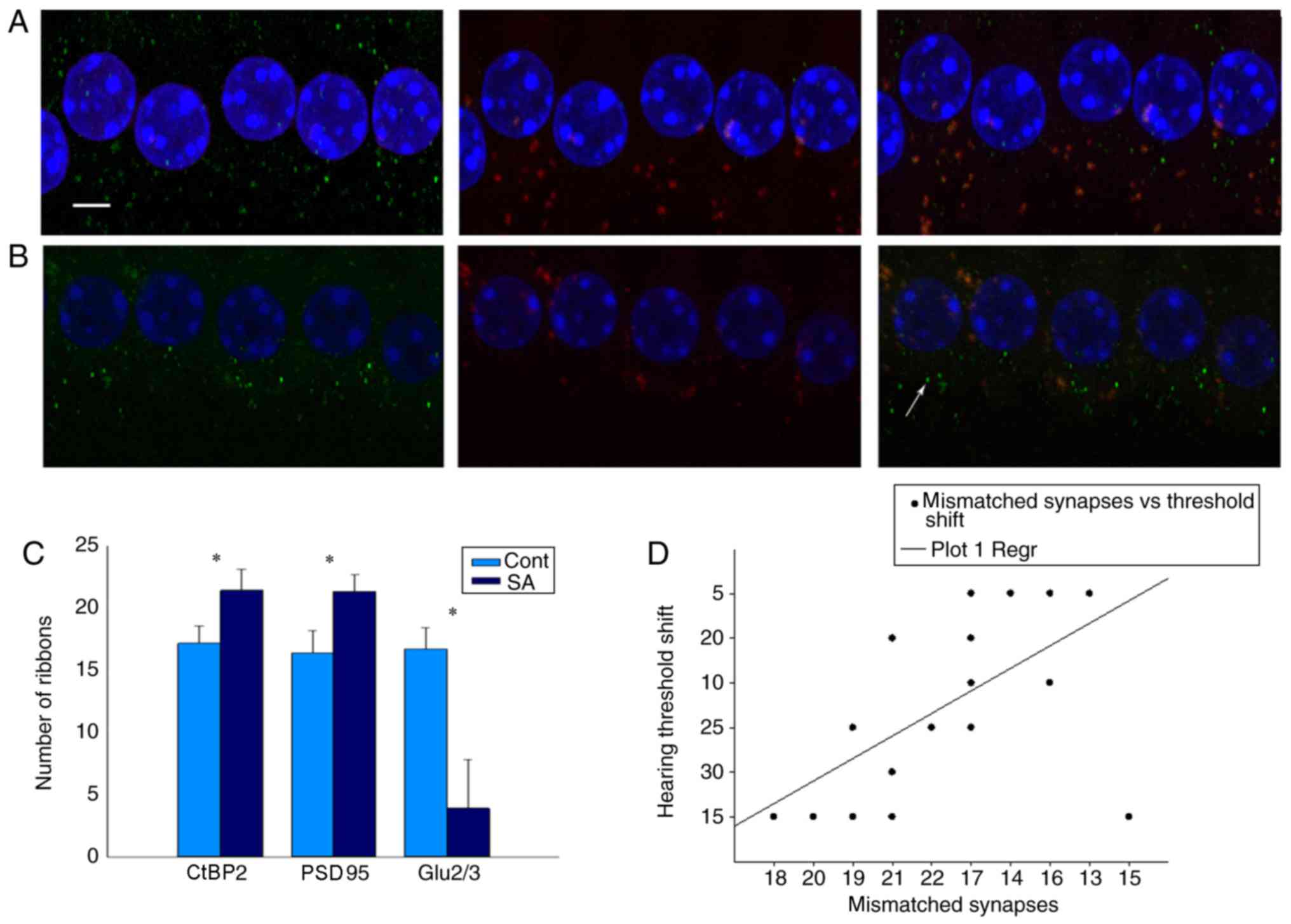|
1
|
Fresca TM, Salvi RF and Archela RS:
Dimensões do espaço paranaense. Editora UEL, Londrina. 2002.
|
|
2
|
Moller AR: Pathophysiology of tinnitus.
Otolaryngol Clin North Am. 36:249–266, v-vi. 2003. View Article : Google Scholar : PubMed/NCBI
|
|
3
|
Jastreboff PJ: Tinnitus retraining
therapy. Prog Brain Res. 166:415–423. 2007. View Article : Google Scholar : PubMed/NCBI
|
|
4
|
Zenner HP, Pfister M and Birbaumer N:
Tinnitus sensitization: Sensory and psychophysiological aspects of
a new pathway of acquired centralization of chronic tinnitus. Otol
Neurotol. 27:1054–1063. 2006. View Article : Google Scholar : PubMed/NCBI
|
|
5
|
Puel JL and Guitton MJ: Salicylate-induced
tinnitus: molecular mechanisms and modulation by anxiety. Prog
Brain Res. 166:141–146. 2007. View Article : Google Scholar : PubMed/NCBI
|
|
6
|
Leaver AM, Renier L, Chevillet MA, Morgan
S, Kim HJ and Rauschecker JP: Dysregulation of limbic and auditory
networks in tinnitus. Neuron. 69:33–43. 2011. View Article : Google Scholar : PubMed/NCBI
|
|
7
|
Langguth B, Salvi R and Elgoyhen AB:
Emerging pharmacotherapy of tinnitus. Expert Opin Emerg Drugs.
14:687–702. 2009. View Article : Google Scholar : PubMed/NCBI
|
|
8
|
Shargorodsky J, Curhan GC and Farwell WR:
Prevalence and characteristics of tinnitus among US adults. Am J
Med. 123:711–718. 2010. View Article : Google Scholar : PubMed/NCBI
|
|
9
|
Cazals Y: Auditory sensori-neural
alterations induced by salicylate. Prog Neurobiol. 62:583–631.
2000. View Article : Google Scholar : PubMed/NCBI
|
|
10
|
Jastreboff PJ, Brennan JF, Coleman JK and
Sasaki CT: Phantom auditory sensation in rats: An animal model for
tinnitus. Behav Neurosci. 102:811–822. 1988. View Article : Google Scholar : PubMed/NCBI
|
|
11
|
Jastreboff PJ, Brennan JF and Sasaki CT:
An animal model for tinnitus. Laryngoscope. 98:280–286. 1988.
View Article : Google Scholar : PubMed/NCBI
|
|
12
|
Escoubet B, Amsallem P, Ferrary E and Tran
Ba Huy P: Prostaglandin synthesis by the cochlea of the guinea pig.
Influence of aspirin, gentamicin and acoustic stimulation.
Prostaglandins. 29:589–599. 1985. View Article : Google Scholar : PubMed/NCBI
|
|
13
|
Jung TT, Miller SK, Rozehnal S, Woo HY,
Park YM and Baer W: Effect of round window membrane application of
salicylate and indomethacin on hearing and levels of arachidonic
acid metabolites in perilymph. Acta Otolaryngol Suppl. 493:81–87.
1992.PubMed/NCBI
|
|
14
|
Martin WH, Schwegler JW, Scheibelhoffer J
and Ronis ML: Salicylate-induced changes in cat auditory nerve
activity. Laryngoscope. 103:600–604. 1993. View Article : Google Scholar : PubMed/NCBI
|
|
15
|
Singer W, Zuccotti A, Jaumann M, Lee SC,
Panford-Walsh R, Xiong H, Zimmermann U, Franz C, Geisler HS,
Köpschall I, et al: Noise-induced inner hair cell ribbon loss
disturbs central arc mobilization: A novel molecular paradigm for
understanding tinnitus. Mol Neurobiol. 47:261–279. 2013. View Article : Google Scholar : PubMed/NCBI
|
|
16
|
Bernstein JM and Weiss AD: Further
observations on salicylate ototoxicity. J Laryngol Otol.
81:915–925. 1967. View Article : Google Scholar : PubMed/NCBI
|
|
17
|
Didier A, Miller JM and Nuttall AL: The
vascular component of sodium salicylate ototoxicity in the guinea
pig. Hear Res. 69:199–206. 1993. View Article : Google Scholar : PubMed/NCBI
|
|
18
|
McFadden D, Plattsmier HS and Pasanen EG:
Aspirin-induced hearing loss as a model of sensorineural hearing
loss. Hear Res. 16:251–260. 1984. View Article : Google Scholar : PubMed/NCBI
|
|
19
|
McFadden D, Plattsmier HS and Pasanen EG:
Temporary hearing loss induced by combinations of intense sounds
and nonsteroidal anti-inflammatory drugs. Am J Otolaryngol.
5:235–241. 1984. View Article : Google Scholar : PubMed/NCBI
|
|
20
|
Chen GD, Kermany MH, D'Elia A, Ralli M,
Tanaka C, Bielefeld EC, Ding D, Henderson D and Salvi R: Too much
of a good thing: Long-term treatment with salicylate strengthens
outer hair cell function but impairs auditory neural activity. Hear
Res. 265:63–69. 2010. View Article : Google Scholar : PubMed/NCBI
|
|
21
|
Yu N, Zhu ML, Johnson B, Liu YP, Jones RO
and Zhao HB: Prestin up-regulation in chronic salicylate (aspirin)
administration: An implication of functional dependence of prestin
expression. Cell Mol Life Sci. 65:2407–2418. 2008. View Article : Google Scholar : PubMed/NCBI
|
|
22
|
Bourre JM, Durand G, Erre JP and Aran JM:
Changes in auditory brainstem responses in alpha-linolenic acid
deficiency as a function of age in rats. Audiology. 38:13–18. 1999.
View Article : Google Scholar : PubMed/NCBI
|
|
23
|
Moser T, Neef A and Khimich D: Mechanisms
underlying the temporal precision of sound coding at the inner hair
cell ribbon synapse. J Physiol. 576:55–62. 2006. View Article : Google Scholar : PubMed/NCBI
|
|
24
|
Starr A, Picton TW, Sininger Y, Hood LJ
and Berlin CI: Auditory neuropathy. Brain. 119:741–753. 1996.
View Article : Google Scholar : PubMed/NCBI
|
|
25
|
Sudhof TC: The synaptic vesicle cycle.
Annu Rev Neurosci. 27:509–547. 2004. View Article : Google Scholar : PubMed/NCBI
|
|
26
|
Roux I, Safieddine S, Nouvian R, Grati M,
Simmler MC, Bahloul A, Perfettini I, Le Gall M, Rostaing P, Hamard
G, et al: Otoferlin, defective in a human deafness form, is
essential for exocytosis at the auditory ribbon synapse. Cell.
127:277–289. 2006. View Article : Google Scholar : PubMed/NCBI
|
|
27
|
Maier W, Bednorz M, Meister S, Roebroek A,
Weggen S, Schmitt U and Pietrzik CU: LRP1 is critical for the
surface distribution and internalization of the NR2B NMDA receptor
subtype. Mol Neurodegener. 8:252013. View Article : Google Scholar : PubMed/NCBI
|
|
28
|
Wang Q and Green SH: Functional role of
neurotrophin-3 in synapse regeneration by spiral ganglion neurons
on inner hair cells after excitotoxic trauma in vitro. J Neurosci.
31:7938–7949. 2011. View Article : Google Scholar : PubMed/NCBI
|
|
29
|
Biou V, Bhattacharyya S and Malenka RC:
Endocytosis and recycling of AMPA receptors lacking GluR2/3. Proc
Natl Acad Sci USA. 105:1038–1043. 2008. View Article : Google Scholar : PubMed/NCBI
|
|
30
|
Ma B, Wang L, von Wasielewski R,
Lindenmaier W and Dittmar KE: Serial sectioning and
three-dimensional reconstruction of mouse Peyer's patch. Micron.
39:967–975. 2008. View Article : Google Scholar : PubMed/NCBI
|
|
31
|
Filippi S, Motyl B and Bandera C: Analysis
of existing methods for 3D modelling of femurs starting from two
orthogonal images and development of a script for a commercial
software package. Comput Methods Programs Biomed. 89:76–82. 2008.
View Article : Google Scholar : PubMed/NCBI
|
|
32
|
Gruska M, Medalia O, Baumeister W and Leis
A: Electron tomography of vitreous sections from cultured mammalian
cells. J Struct Biol. 161:384–392. 2008. View Article : Google Scholar : PubMed/NCBI
|
|
33
|
Punge A, Rizzoli SO, Jahn R, Wildanger JD,
Meyer L, Schönle A, Kastrup L and Hell SW: 3D reconstruction of
high-resolution STED microscope images. Microsc Res Tech.
71:644–650. 2008. View Article : Google Scholar : PubMed/NCBI
|
|
34
|
Nakagawa T, Komune S, Uemura T and Akaike
N: Excitatory amino acid response in isolated spiral ganglion cells
of guinea pig cochlea. J Neurophysiol. 65:715–723. 1991. View Article : Google Scholar : PubMed/NCBI
|
|
35
|
Ruel J, Chen C, Pujol R, Bobbin RP and
Puel JL: AMPA-preferring glutamate receptors in cochlear physiology
of adult guinea-pig. J Physiol. 518:667–680. 1999. View Article : Google Scholar : PubMed/NCBI
|
|
36
|
Glowatzki E and Fuchs PA: Transmitter
release at the hair cell ribbon synapse. Nat Neurosci. 5:147–154.
2002. View Article : Google Scholar : PubMed/NCBI
|
|
37
|
Ruel J, Chabbert C, Nouvian R, Bendris R,
Eybalin M, Leger CL, Bourien J, Mersel M and Puel JL: Salicylate
enables cochlear arachidonic-acid-sensitive NMDA receptor
responses. J Neurosci. 28:7313–7323. 2008. View Article : Google Scholar : PubMed/NCBI
|
|
38
|
Khimich D, Nouvian R, Pujol R, Tom Dieck
S, Egner A, Gundelfinger ED and Moser T: Hair cell synaptic ribbons
are essential for synchronous auditory signalling. Nature.
434:889–894. 2005. View Article : Google Scholar : PubMed/NCBI
|
|
39
|
Xi D, Li YC, Snyder MA, Gao RY, Adelman
AE, Zhang W, Shumsky JS and Gao WJ: Group II metabotropic glutamate
receptor agonist ameliorates MK801-induced dysfunction of NMDA
receptors via the Akt/GSK-3β pathway in adult rat prefrontal
cortex. Neuropsychopharmacology. 36:1260–1274. 2011. View Article : Google Scholar : PubMed/NCBI
|
|
40
|
Berretta N and Jones RS: Tonic
facilitation of glutamate release by presynaptic
N-methyl-D-aspartate autoreceptors in the entorhinal cortex.
Neuroscience. 75:339–344. 1996. View Article : Google Scholar : PubMed/NCBI
|
|
41
|
Breukel AI, Besselsen E, Lopes da Silva FH
and Ghijsen WE: A presynaptic N-methyl-D-aspartate autoreceptor in
rat hippocampus modulating amino acid release from a cytoplasmic
pool. Eur J Neurosci. 10:106–114. 1998. View Article : Google Scholar : PubMed/NCBI
|
|
42
|
Woodhall G, Evans DI, Cunningham MO and
Jones RS: NR2B-containing NMDA autoreceptors at synapses on
entorhinal cortical neurons. J Neurophysiol. 86:1644–1651. 2001.
View Article : Google Scholar : PubMed/NCBI
|
|
43
|
Luccini E, Musante V, Neri E, Raiteri M
and Pittaluga A: N-methyl-D-aspartate autoreceptors respond to low
and high agonist concentrations by facilitating, respectively,
exocytosis and carrier-mediated release of glutamate in rat
hippocampus. J Neurosci Res. 85:3657–3665. 2007. View Article : Google Scholar : PubMed/NCBI
|
|
44
|
Chen Z, Kujawa SG and Sewell WF: Auditory
sensitivity regulation via rapid changes in expression of surface
AMPA receptors. Nat Neurosci. 10:1238–1240. 2007. View Article : Google Scholar : PubMed/NCBI
|
|
45
|
Mazurek B, Lou X, Olze H, Haupt H and
Szczepek AJ: In vitro protection of auditory hair cells by
salicylate from the gentamicin-induced but not neomycin-induced
cell loss. Neurosci Lett. 506:107–110. 2012. View Article : Google Scholar : PubMed/NCBI
|
|
46
|
Shi L, Liu L, He T, Guo X, Yu Z, Yin S and
Wang J: Ribbon synapse plasticity in the cochleae of Guinea pigs
after noise-induced silent damage. PLoS One. 8:e815662013.
View Article : Google Scholar : PubMed/NCBI
|
|
47
|
Chubykin AA, Atasoy D, Etherton MR, Brose
N, Kavalali ET, Gibson JR and Südhof TC: Activity-dependent
validation of excitatory versus inhibitory synapses by neuroligin-1
versus neuroligin-2. Neuron. 54:919–931. 2007. View Article : Google Scholar : PubMed/NCBI
|
|
48
|
Mishra A, Traut MH, Becker L, Klopstock T,
Stein V and Klein R: Genetic evidence for the adhesion protein
IgSF9/Dasm1 to regulate inhibitory synapse development independent
of its intracellular domain. J Neurosci. 34:4187–4199. 2014.
View Article : Google Scholar : PubMed/NCBI
|
|
49
|
Zugaib J and Leao RM: Enhancement of
endocannabinoid-dependent depolarization-induced suppression of
excitation in glycinergic neurons by prolonged exposure to high
doses of salicylate. Neuroscience. 376:72–79. 2018. View Article : Google Scholar : PubMed/NCBI
|


















